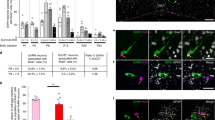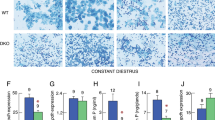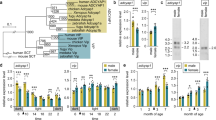Abstract
Adult male sexual behavior in mammals requires the neuronal organizing effects of gonadal steroids during a sensitive perinatal period. During development, estradiol differentiates the rat preoptic area (POA), an essential brain region in the male copulatory circuit. Here we report that increases in prostaglandin-E2 (PGE2), resulting from changes in cyclooxygenase-2 (COX-2) regulation induced by perinatal exposure to estradiol, are necessary and sufficient to organize the crucial neural substrate that mediates male sexual behavior. Briefly preventing prostaglandin synthesis in newborn males with the COX inhibitor indomethacin permanently downregulates markers of dendritic spines in the POA and severely impairs male sexual behavior. Developmental exposure to the COX inhibitor aspirin results in mild impairment of sexual behavior. Conversely, administration of PGE2 to newborn females masculinizes the POA and leads to male sex behavior in adults, thereby highlighting the pathway of steroid-independent brain masculinization. Our findings show that PGE2 functions as a downstream effector of estradiol to permanently masculinize the brain.
This is a preview of subscription content, access via your institution
Access options
Subscribe to this journal
Receive 12 print issues and online access
$209.00 per year
only $17.42 per issue
Buy this article
- Purchase on Springer Link
- Instant access to full article PDF
Prices may be subject to local taxes which are calculated during checkout





Similar content being viewed by others
References
Ryner, L.C. et al. Control of male sexual behavior and sexual orientation in Drosophila by the fruitless gene. Cell 87, 1079–1089 (1996).
Emmons, S.W. & Lipton, J. Genetic basis of male sexual behavior. J. Neurobiol. 54, 93–110 (2003).
Weisz, J. & Ward, I.L. Plasma testosterone and progesterone titers of pregnant rats, their male and female fetuses, and neonatal offspring. Endocrinology 106, 306–316 (1980).
De Vries, G. & Simerly, R. Anatomy, development, and function of sexually dimorphic neural circuits in the mammalian brain. in Hormones, Brain and Behavior (eds. Pfaff, D., Arnold, A., Etgen, A., Fahrbach, S. & Rubin, R.) 137–192 (Academic, San Diego, CA, 2002).
Simerly, R.B. Wired for reproduction: organization and development of sexually dimorphic circuits in the mammalian forebrain. Annu. Rev. Neurosci. 25, 507–536 (2002).
Christensen, L.W., Nance, D.M. & Gorski, R.A. Effects of hypothalamic and preoptic lesions on reproductive behavior in male rats. Brain Res. Bull. 2, 137–141 (1977).
Gorski, R.A., Harlan, R.E., Jacobson, C.D., Shryne, J.E. & Southam, A.M. Evidence for the existence of a sexually dimorphic nucleus in the preoptic area of the rat. J. Comp. Neurol. 193, 529–539 (1980).
Davis, E.C., Popper, P. & Gorski, R.A. The role of apoptosis in sexual differentiation of the rat sexually dimorphic nucleus of the preoptic area. Brain Res. 734, 10–18 (1996).
Pfaff, D.W. Morphological changes in the brains of adult male rats after neonatal castration. J. Endocrinol. 36, 415–416 (1966).
Raisman, G. & Field, P.M. Sexual dimorphism in the preoptic area of the rat. Science 173, 731–733 (1971).
Larriva-Sahd, J. Ultrastructural evidence of a sexual dimorphism in the neuropil of the medial preoptic nucleus of the rat: a quantitative study. Neuroendocrinology 54, 416–419 (1991).
Perez, J., Naftolin, F. & Garcia Segura, L.M. Sexual differentiation of synaptic connectivity and neuronal plasma membrane in the arcuate nucleus of the rat hypothalamus. Brain Res. 527, 116–122 (1990).
Woolley, C.S. & McEwen, B.S. Estradiol mediates fluctuation in hippocampal synapse density during the estrous cycle in the adult rat. J. Neurosci. 12, 2549–3554 (1992).
Calizo, L.H. & Flanagan-Cato, L.M. Estrogen selectively regulates spine density within the dendritic arbor of rat ventromedial hypothalamic neurons. J. Neurosci. 20, 1589–1596 (2000).
Mong, J.A., Roberts, R.C., Kelly, J.J. & McCarthy, M.M. Gonadal steroids reduce the density of axospinous synapses in the developing rat arcuate nucleus: an electron microscopy analysis. J. Comp. Neurol. 432, 259–267 (2001).
Amateau, S.K. & McCarthy, M.M. A novel mechanism of dendritic spine plasticity involving estradiol induction of prostaglandin-E2 . J. Neurosci. 22, 8586–8596 (2002).
Feng, J. et al. Spinophilin regulates the formation and function of dendritic spines. Proc. Natl. Acad. Sci. USA 97, 9287–9292 (2000).
Stephens, D.J. & Banting, G. In vivo dynamics of the F-actin-binding protein neurabin-II. Biochem. J. 345, 185–194 (2000).
Goldin, M., Segal, M. & Avignone, E. Functional plasticity triggers formation and pruning of dendritic spines in cultured hippocampal networks. J. Neurosci. 21, 186–193 (2001).
Herrmann, K. Differential distribution of AMPA receptors and glutamate during pre- and postnatal development in the visual cortex of ferrets. J. Comp. Neurol. 375, 1–17 (1996).
Green, G.A. Understanding NSAIDs: from aspirin to COX-2. Clin. Cornerstone 3, 5–60 (2001).
Pfaus, J.G. et al. Sexual behavior enhances central dopamine transmission in the male rat. Brain Res. 530, 345–348 (1990).
Dewsbury, D.A. Copulatory behaviour of rats (Rattus norvegicus) as a function of prior copulatory experience. Anim. Behav. 17, 217–223 (1969).
Murphy, A.Z. & Hoffman, G.E. Distribution of gonadal steroid receptor-containing neurons in the preoptic-periaqueductal gray-brainstem pathway: a potential circuit for the initiation of male sexual behavior. J. Comp. Neurol. 438, 191–212 (2001).
Truitt, W.A. & Coolen, L.M. Identification of a potential ejaculation generator in the spinal cord. Science 297, 1566–1569 (2002).
Powell, W.S., Dominguez, J.M. & Hull, E.M. An NMDA antagonist impairs copulation and the experience-induced enhancement of male sexual behavior in the rat. Behav. Neurosci. 117, 69–75 (2003).
Forger, N.G., Wagner, C.K., Contois, M., Bengston, L. & MacLennan, A.J. Ciliary neurotrophic factor receptor α in spinal motoneurons is regulated by gonadal hormones. J. Neurosci. 18, 8720–8729 (1998).
Gorski, R.A., Gordon, J.H., Shryne, J.E. & Southam, A.M. Evidence for a morphological sex difference within the medial preoptic area of the rat brain. Brain Res. 148, 333–346 (1978).
Meisel, R.L. & Sachs, B.D. The physiology of male sexual behavior. in The Physiology of Reproduction (eds. Knobil, E. & Neill, J.D.) 3–107 (Raven, New York, NY, 1994).
Baum, M. Neuroendocrinology of sexual behavior in the male. in Behavioral Endocrinolgy (eds. Becker, J., Breedlove, S.M., Crews, D. & McCarthy, M.) 153–203 (MIT Press, Cambridge, MA, 2002).
Beach, F.A. & Holz, A.M. Mating behavior in male rats castrated at various ages and injected with androgen. J. Exp. Zool. 101, 91–142 (1946).
Davis, A.M., Grattan, D.R. & McCarthy, M.M. Decreasing GAD neonatally attenuates steroid-induced sexual differentiation of the rat brain. Behav. Neurosci. 114, 923–933 (2000).
Feng, P., Ma, Y. & Vogel, G.W. The critical window of brain development from susceptive to insusceptive. Effects of clomipramine neonatal treatment on sexual behavior. Brain Res. Dev. Brain Res. 129, 107–110 (2001).
Auger, A.P. et al. Expression of the nuclear receptor coactivator, cAMP response element-binding protein, is sexually dimorphic and modulates sexual differentiation of neonatal rat brain. Endocrinology 143, 3009–3016 (2002).
Hull, E., Meisel, R. & Sachs, D. Male sexual behavior. in Hormones, Brain, and Behavior (ed. Pfaff, D.W.) 3–137 (Academic, San Diego, CA, 2002).
Houtsmuller, E.J. et al. SDN-POA volume, sexual behavior, and partner preference of male rats affected by perinatal treatment with ATD. Physiol. Behav. 56, 535–541 (1994).
Roselli, C.E., Cross, E., Poonyagariyagorn, H.K. & Stadelman, H.L. Role of aromatization in anticipatory and consummatory aspects of sexual behavior in male rats. Horm. Behav. 44, 146–151 (2003).
George, F.W. & Ojeda, S.R. Changes in aromatase activity in the rat brain during embryonic, neonatal, and infantile development. Endocrinology 111, 522–529 (1982).
Shughrue, P.J., Lane, M.V. & Merchenthaler, I. Comparative distribution of estrogen receptor-α and -β mRNA in the rat central nervous system. J. Comp. Neurol. 388, 507–525 (1997).
Breder, C.D., Dewitt, D. & Kraig, R.P. Characterization of inducible cyclooxygenase in rat brain. J. Comp. Neurol. 355, 296–315 (1995).
Sorra, K.E. & Harris, K.M. Overview on the structure, composition, function, development, and plasticity of hippocampal dendritic spines. Hippocampus 10, 501–511 (2000).
Phoenix, C.H., Goy, R.W., Gerall, A.A. & Young, W.C. Organizing action of prenatally administered testosterone propionate in the tissues mediating mating and behavior in the female guinea pig. Endocrinology 65, 369–382 (1959).
Malenka, R.C. The role of postsynaptic calcium in the induction of long-term potentiation. Mol. Neurobiol. 5, 289–295 (1991).
Levy, G. Clinical pharmacokinetics of aspirin. Pediatrics 62, 867–872 (1978).
Helleberg, L. Clinical pharmacokinetics of indomethacin. Clin. Pharmacokinet. 6, 245–258 (1981).
Glaser, E.M. & Van der Loos, H. Analysis of thick brain sections by obverse-reverse computer microscopy: application of a new, high clarity Golgi-Nissl stain. J. Neurosci. Methods 4, 117–125 (1981).
Mong, J.A., Glaser, E. & McCarthy, M.M. Gonadal steroids promote glial differentiation and alter neuronal morphology in the developing hypothalamus in a regionally specific manner. J. Neurosci. 19, 1464–1472 (1999).
Harris, K.M., Jensen, F.E. & Tsao, B. Three-dimensional structure of dendritic spines and synapses in rat hippocampus (CA1) at postnatal day 15 and adult ages: implications for the maturation of synaptic physiology and long-term potentiation. J. Neurosci. 12, 2685–2705 (1992).
McMullen, N.T. & Almli, C.R. Cell types within the medial forebrain bundle: a Golgi study of preoptic and hypothalamic neurons in the rat. Am. J. Anat. 161, 323–340 (1981).
Amateau, S.K., Alt, J.J., Stamps, C.L. & McCarthy, M.M. Brain estradiol content in newborn rats: sex differences, regional heterogeneity and possible de novo synthesis by the female telencephalon. Endocrinology 145, 2906–2917 (2004).
Acknowledgements
We thank J.J. Alt for assistance with culture preparation and Golgi-Cox impregnation; J.M. Jones for the quantitative real-time PCR experiment; J.A. Mong for technical guidance in the Golgi experiment; and G.F. Ball, A.Z. Murphy and B.J. Todd for comments on the manuscript. This work was supported by a predoctoral National Research Service Award to S.K.A. (MH12862); a grant from the National Institutes of Mental Health to M.M.M. (MH52716); and by the National Institute of Child Health and Human Development (NICHD) and NIH through cooperative agreement (U54 HD28934) as part of the Specialized Cooperative Centers Program in Reproductive Research.
Author information
Authors and Affiliations
Corresponding author
Ethics declarations
Competing interests
The authors declare no competing financial interests.
Supplementary information
Rights and permissions
About this article
Cite this article
Amateau, S., McCarthy, M. Induction of PGE2 by estradiol mediates developmental masculinization of sex behavior. Nat Neurosci 7, 643–650 (2004). https://doi.org/10.1038/nn1254
Received:
Accepted:
Published:
Issue Date:
DOI: https://doi.org/10.1038/nn1254
This article is cited by
-
Hormonal, Genetic, Immunological: An Array of Mechanisms but How Do They Interact, If at All?
Archives of Sexual Behavior (2023)
-
Neurogenesis in the neonatal rat hippocampus is regulated by sexually dimorphic epigenetic modifiers
Biology of Sex Differences (2022)
-
Paracetamol use during pregnancy — a call for precautionary action
Nature Reviews Endocrinology (2021)
-
A new view of sexual differentiation of mammalian brain
Journal of Comparative Physiology A (2020)
-
Sex differences in neuroimmunity as an inherent risk factor
Neuropsychopharmacology (2019)



